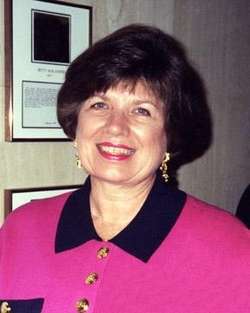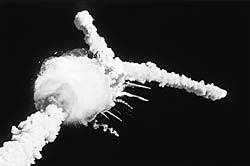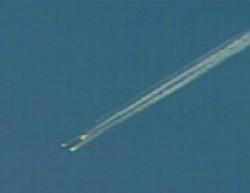JoAnn Morgan Saw It All And Broke A Few Gender Barriers Along
The Way
 What's it like being one
of the very first women ever to join NASA? JoAnn Morgan, who
retires from the space agency soon, has a unique perspective on
that issue. She joined the space program in 1958, before NASA was
even created, as an 18-year old student from the University of
Florida. She loved the work, the people and the missions. In Part
One, Ms. Morgan was kind enough to remember some of the milestones
and distinct personalities she witnessed as a 45-year NASA veteran.
She continues that rememberance in this second part of the story.
But she also recalls her personal mission to be fully accepted as a
space-flight team member:
What's it like being one
of the very first women ever to join NASA? JoAnn Morgan, who
retires from the space agency soon, has a unique perspective on
that issue. She joined the space program in 1958, before NASA was
even created, as an 18-year old student from the University of
Florida. She loved the work, the people and the missions. In Part
One, Ms. Morgan was kind enough to remember some of the milestones
and distinct personalities she witnessed as a 45-year NASA veteran.
She continues that rememberance in this second part of the story.
But she also recalls her personal mission to be fully accepted as a
space-flight team member:
"I guess I mark time in two ways," said JoAnn Morgan, who'll
soon retire from NASA after 45 years on the job. "I look at my own
career progression, often near the top. I got there by working hard
and doing jobs others wouldn't. I also mark time in terms of the
missions we've completed, in terms of our accomplishments."
She knows first hand about progress. From a college intern who
was "part of the team" just four days after she arrived at Cape
Canaveral in 1958, she's risen through the ranks of NASA to become
one of its senior leaders.
Morgan's career spans 45 years and includes a list of firsts at
KSC, including her appointment as the first woman senior executive
at the space center. She has been in leadership roles at KSC for
the past 20 years.
Her list of firsts also includes first woman in the
Launch Control Center Firing Room during the Apollo program; first
woman division chief; first woman to win a NASA medal; first woman
senior executive at KSC; first woman associate director for KSC and
first woman to act as deputy director of KSC. Additionally, Morgan
was the first woman in NASA to win the coveted Sloan Fellowship.
The Sloan Fellowship is one of the NASA fellowship programs and
grants fellowships to MIT in Massachusetts and Stanford University
(CA), for graduate study. The program is international and includes
students from government and industry in the United States and
abroad.
"JoAnn's career is a model of success," said KSC
Director Roy Bridges Jr. "She is the pioneer for all the female
engineers at NASA. She is my hero, too. She has a passion for
excellence that is rarely exceeded. She thinks 'out of the box' and
makes things happen. What a joy to work with her!"
It's not hard to feel JoAnn's level of commitment and energy,
even on the telephone from 2000 miles away. That's fairly
remarkable, given the fact she ran into a lot of roadblocks along
the way.
"Logistics were hard," she said without a trace of bitterness in
her voice. "For instance, there were no women's rest rooms at the
launchpad. I had to get a security guard to clear out the
restroom." That's what she had to do from the moment she joined the
space program in 1958, until NASA built a new launch facility for
the Apollo missions in the 1960s.

Convincing her fellow NASA workers to treat her as a part of the
team wasn't any easier. "I buried myself in the job," she said. "If
I found a man who didn't want me there, I ignored him." That
happened a lot, she said. For instance, when she joined the Apollo
project, she encountered one supervisor in the launch facility who
told her flat out that women weren't allowed in the blockhouse.
JoAnn had been given a procedural task to complete. At a loss, she
called her own supervisor, who told her without hesitation to
complete the task. Only later, said Ms. Morgan, did she find out
that her supervisor had called all over the space agency and asked,
"What gives?" until the harrassment stopped. While JoAnn said that
went a long way to quelling the testosterone rebellion against her,
it didn't stop. Not long after Apollo Pad 39 was constructed, she
said a launch director "poo-poohed" her presence there. The very
next day, she said, the Apollo launch manager made it a point to
pat her on the back and give her a rather elaborate welcome. Point
taken.
The Slump
As the Apollo program came to an end, JoAnn, like a lot of
people at NASA, found herself looking for something to do. "We went
from four launches in a year to two in a decade," she said. But Ms.
Morgan remained committed to the space program and that commitment
led her to work on the Skylab and Apollo-Soyuz missions, paving the
way for the creation of an International Space Station.
She also took time to better her education, attending
Stanford University and assuring her continued rise through the
ranks. She then became one of the KSC team developing the Space
Shuttle launch processing system central data subsystem, which was
initially used for the first launch of the orbiter
Columbia. Following that, she served in managerial
positions including division chief and deputy director, Expendable
Launch Vehicles; director of Payload Projects and Ground
Operations; and director for Safety and Mission Assurance with
overall responsibilities for the KSC safety, reliability,
maintainability, quality and mission assurance programs.
Challenger
 On that cold February
morning in 1986 (you know the one), Many members of the
Challenger launch team were iced in, according to Ms.
Morgan. "We had all been working so hard, we were all very tired,"
she remembers. "I got up that morning and saw a white something. I
didn't know what it was at first. It was an icicle hanging off the
boat motor. So I didn't go in that day. I felt like it wasn't the
right day to launch. When I saw the launch and what happened, I was
just frustrated. It didn't need to happen!"
On that cold February
morning in 1986 (you know the one), Many members of the
Challenger launch team were iced in, according to Ms.
Morgan. "We had all been working so hard, we were all very tired,"
she remembers. "I got up that morning and saw a white something. I
didn't know what it was at first. It was an icicle hanging off the
boat motor. So I didn't go in that day. I felt like it wasn't the
right day to launch. When I saw the launch and what happened, I was
just frustrated. It didn't need to happen!"
At the time, she said, NASA was leaderless, a factor she
believes contributed to the demise of Challenger. "We're
not an agency that copes well without quality leadership. We need
leaders who understand procedures, but who also know how to listen.
Our people are "can-do" people. They respond to leaders." She
offered a critical glimpse into NASA culture, the very subject of
the CAIB investigation and the Return To Flight Task Force.
"The little clues (leading to the Challenger disaster)
were there," she said wistfully. "But there weren't enough people
in the program who knew to pick them up. The program is the king.
So people circled the wagons. They got into a group think. We had a
number of outside groups, but maybe we had too many. They didn't
have the clout they should have."
Columbia: "We're Having A Bad Day, JoAnn."
 "I was there at KSC for the
landing," JoAnn said, referring to the Columbia disaster,
almost 17 years after Challenger exploded shortly after
launch. "I was babysitting the press. At some point, a reporter
from USA Today realized we hadn't heard the sonic booms
(characteristic of shuttle landings). I ran inside and was told,
'We're having a bad day, JoAnn.'"
"I was there at KSC for the
landing," JoAnn said, referring to the Columbia disaster,
almost 17 years after Challenger exploded shortly after
launch. "I was babysitting the press. At some point, a reporter
from USA Today realized we hadn't heard the sonic booms
(characteristic of shuttle landings). I ran inside and was told,
'We're having a bad day, JoAnn.'"
That simple, stark statement came after controllers lost touch
with Columbia, just about 30 minutes before touchdown. "We
had lost all communications systems. I know those systems are so
robust that if they all go out, something really bad has happened."
She recalls that NASA Administrator Sean O'Keefe was there with her
and the families. "He just did an incredible job," said Ms. Morgan.
"We got out our contingency plans. He called the president and
explained what happened. Then he told the families." It's clear in
those words the admiration Ms. Morgan holds for the NASA chief.
The Day After Tomorrow
Remembering the past, JoAnn turned to the future. "I
believe in the commercialization of space," she said, "but tehre's
not enough money in it right now to make the commercialization of
space viable."
 That could change, she
admitted, if the United States is spurred to action by, of all
countries, The People's Republic of China. Seeing the ambitious
plans China has for space exploration and the development of a
lunar mining colony, JoAnn thinks we might just enter a new space
race. She hopes that could mean a better budget for NASA. "We need
to get people inspired. I think I can help with that."
That could change, she
admitted, if the United States is spurred to action by, of all
countries, The People's Republic of China. Seeing the ambitious
plans China has for space exploration and the development of a
lunar mining colony, JoAnn thinks we might just enter a new space
race. She hopes that could mean a better budget for NASA. "We need
to get people inspired. I think I can help with that."
Perhaps so. Florida Governor Jeb Bush has appointed Ms. Morgan
to the University of Florida system Board of Trustees, where she'll
help develop programs that honor astronauts and foster a growth in
science education.
That quest, she said, is greatly facilitated by one of the
projects she holds dearest, the Hubble Space Telescope. "I worked
on Hubble for ten years. All I studied before then has been
outdated by Hubble. It's rewritted the same astronomy books I
learned from. I'm so proud to have been a part of that -- rewriting
history."
 SpaceX to Launch Inversion RAY Reentry Vehicle in Fall
SpaceX to Launch Inversion RAY Reentry Vehicle in Fall Aero-News: Quote of the Day (04.23.24)
Aero-News: Quote of the Day (04.23.24) Aero-News: Quote of the Day (04.20.24)
Aero-News: Quote of the Day (04.20.24) ANN's Daily Aero-Linx (04.20.24)
ANN's Daily Aero-Linx (04.20.24) Aero-News: Quote of the Day (04.21.24)
Aero-News: Quote of the Day (04.21.24)







